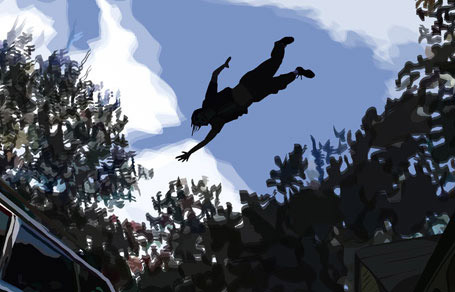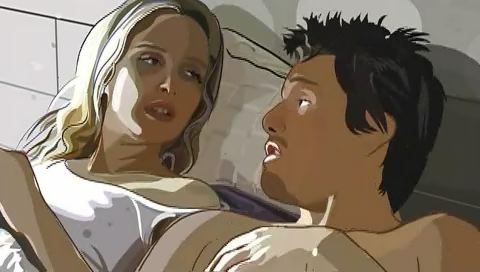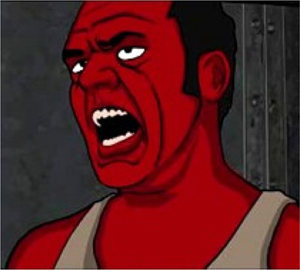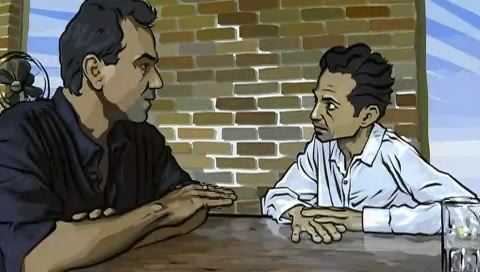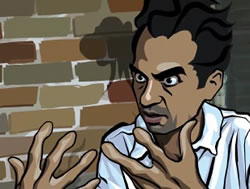From the Chicago Reader (October 26, 2001). — J.R.
Waking Life
****
Directed and written by Richard Linklater.
The cinema is an antiuniverse where reality is born out of a sum of unrealities. –Jean Epstein
I must have come across this statement by Epstein, a French theorist and filmmaker (1897-1953), in the late 60s or early 70s, but I no longer remember where. I’ve scanned his writings on several occasions since, but I haven’t found the quote. Sometimes I wonder if I read or heard about it in a dream — making it one of the unrealities Epstein is referring to.
Wherever the quote comes from, it applies beautifully to the animated feature by Richard Linklater that premiered at Sundance early this year and is currently playing at the Music Box. The movie is a string of paradoxes and reflections about what’s real and what’s not, about when you’re dreaming and when you’re awake, and the unusual way it’s put together seems calculated to complicate all of the issues it raises rather than resolve any of them. Over 25 days Linklater, one of his coproducers, and a sound person shot a first version of everything we see in this movie with two relatively low-tech digital video cameras in and around Austin and in San Antonio and New York — basically taping a lot of people talking and walking, as well as listening and sitting. It’s not clear how much of the talk was scripted by Linklater and how much was improvised, but if the methodology of his second feature, Slacker — the live-action Linklater film Waking Life most resembles — is any indication, it was mainly scripted. Much of the editing was done right after the shooting. Then animator Bob Sabiston, credited as art director, spent about nine months with a software program he developed, a good many Mac G4 computers, and more than 30 artists who “painted” over the live-action footage, each one generally assigned one or more characters. About 250 hours of animation work were needed to create — or, more precisely, re-create — each minute of animated footage.
What emerges is so radically different from most animation we’re accustomed to that the movie’s mode perfectly matches its subject — the ambiguous borderline state between waking and dreaming as perceived by actor and sometime animator Wiley Wiggins while he’s drifting around. A constantly shifting panoply of visual styles conjures up a twitching and palpitating universe where everything’s in a perpetual state of becoming, not only from scene to scene but from second to second. In the final sequence — before Wiggins floats off into the sky to the strains of a tango, just after he’s apparently woken up for the umpteenth time — he’s walking down a neighborhood street where everything (plants, trees, cars, dead leaves, even separate sections of flat ground) is unstable and volatile, slipping and sliding and fluctuating with all the unpredictable freedom of an artist’s brush or a deity’s whim. In a world where absolutely nothing can be taken for granted, everything qualifies as a miracle of one sort or another, major or minor, and the business of this movie is to chart as many miracles as possible — dozens, hundreds, even thousands at a time, most of them minor yet exquisite.
One colleague has compared Waking Life to Yellow Submarine, and given all the hallucinogenic play with a constantly constructed reality, it’s easy to see what he means. But the fashionable greeting-card style of George Dunning’s 1968 cartoon extravaganza is miles away from the overall look of this much better movie, which comes closer to evoking the grimmer styles of contemporary graphic novels.
Paradoxically relentless yet easygoing, this philosophical jam session — with its incessant mutter of soaring words creating an almost musical accompaniment that glides in and out of our awareness and comprehension — is too laid-back to be experienced as an assault, yet it calls to mind a constant gentle battering of everyday reality. That Linklater was born in Texas and never went to college undoubtedly has something to do with his “Aw, shucks” manner of interrogating the universe, something he does, quietly yet doggedly, without letup for 97 minutes. I was reminded of a favorite aphorism coined by my father, who, like Linklater, was mainly self-educated: “Life is a bowl of cherries — shot point-blank at you from a cannon.” The cultural reference points include Philip K. Dick, Jean-Luc Godard (whose Masculine-Feminine is cited when one disgruntled pontificator calmly douses himself in gasoline and lights a match), Federico Garcia Lorca, Alberto Giacometti, Lady Gregory, Soren Kierkegaard, D.H. Lawrence, and Thomas Mann, yet the ambience couldn’t be further from the breast-beating soul-searching of Woody Allen or Ingmar Bergman or from the psychedelic bombast of Oliver Stone; low-key, cracker-barrel Fellini is more like it.
This is Linklater’s seventh feature; it was preceded by the Super-8 It’s Impossible to Learn to Plow by Reading Books (1988, never released), Slacker (1990), Dazed and Confused (1993), Before Sunrise (1995), SubUrbia (1997), and The Newton Boys (1998). It’s the first animated film he’s made, but it also qualifies as a kind of composite remake of all these live-action predecessors. Like the first two, it’s essentially plotless, drifting dreamily from one center of attention to the next. Like Dazed and Confused, it features Wiley Wiggins. Like Before Sunrise, it includes Julie Delpy and Ethan Hawke (discovered in bed — a place their characters never got to during their day and night in Vienna — carrying on one of their previous conversations). Like SubUrbia, adapted from a play written by Eric Bogosian, it’s a fairly theatrical performance piece (I assume the same applies to Tape, Linklater’s eighth feature, which I haven’t yet seen but which is scheduled to open here in mid-November) and includes actors Adam Goldberg and Nicky Katt (who also played in Dazed and Confused). And like The Newton Boys, it has a scene filmed inside a jail in Lockhart, Texas, where a tomato red prisoner played by Charles Gunning, a veteran of both The Newton Boys and Slacker, seethes with murderous revenge fantasies involving elaborate torture of the people who put him away (i.e., us): “All you pukes are gonna die the day I get outta this shit hole.” (In a way, this character’s political alienation serves to stand in for everyone else’s in the film — which is quintessentially American and hence automatically familiar.)
There are other carryovers as well. Linklater puts in a couple of appearances that recall the memorable cameo that opens Slacker, in which he recounts a dream, discusses alternative realities, and is seen riding in the backseat of a car. And there’s the “old anarchist” (Louis Mackey) from the same film, and Wiggins’s mother (Mona Lee) from Dazed and Confused. But the key point isn’t the copious self-referentiality; it’s that Linklater — a cinephile who helped found the Austin Film Society in order to teach himself film history — has been bent on remaking cinema in all its diversity since the start of his career, which makes a cartoon the logical next step. He’s already taken on such staples as the youth movie (Dazed and Confused), the romantic love story (Before Sunrise), and the western and crime movie (The Newton Boys); the last two — emotionally as well as visually lavish reworkings and rethinkings of Hollywood splendors — are probably his two most underrated films. I wonder when he’ll get around to making his musical.
One of the strangest aspects of the movie is how much closer it comes to our everyday perceptual reality than the fancies of Disney and the other studio factories, despite — or is it because of? — the unsteadiness of the images, something you’d never find in a Donald Duck or Bugs Bunny or Tom and Jerry. This isn’t because Hollywood cartoons offer talking animals and Linklater doesn’t; on the contrary, at one point he offers us a monkey operating a 16-millimeter film projector and lecturing over the silent footage, as if to drive home the distinctness of his approach. What’s missing is the slickness of studio filmmaking, and what’s added is an unpredictable sense of human agency behind each image, which inflects the film at every turn. This becomes especially eerie when the animation reproduces the effect of shaky handheld pans, as it does during the rehearsal of a tango orchestra.
The press book for Waking Life insists that “there are no geographical references” in the film, and Linklater has made the same point in some of his interviews. Yet having occasionally visited Austin, I immediately recognized portions of the city — the state capitol is plainly visible at least twice. I didn’t feel that Austin was being represented, but that I was being somehow, incidentally yet indelibly, conveyed there.
Similarly, I could readily identify 3 of the 60 or so people rendered by the animation, all of them filmmakers — Linklater, Steven Soderbergh (seen briefly on TV telling an anecdote about an exchange between Louis Malle and Billy Wilder), and Caveh Zahedi, the codirector of A Little Stiff (holding forth on the ontology of cinema as discussed by the great critic and theorist André Bazin) — and all three were captured, not simply caricatured or simulated, their overall presence and individual body language caught in a way that’s uncanny. Zahedi — viewed on a big screen by Wiggins, seated alone inside a movie theater — is especially impressive, a fascinating orchestration of flurries and intensities proceeding simultaneously in separate directions, though not exactly at cross-purposes: grandiloquently jutting explanatory hand gestures, hair that waves like the pulsations of flames, bulging eyes that mark his discourse like punctuation as they expand or contract. That he’s talking mainly about Bazin’s notion of film realism as “holy moments” created by “God incarnate” only adds to the heady brew.
Properly speaking, this novel blend of reality and unreality can’t be credited to just Linklater, who organized the overall thrust and exercised veto power, or to just Sabiston. A cartoon feature may be the closest thing we have nowadays to a collective medieval enterprise like Chartres — the assembly of individual styles, accents, and peccadilloes relates as much to the 60 or so characters portrayed as to the 30-plus animators. (Wiggins is apparently the only one who figured in both capacities. He worked on the scene where he rides on the subway prior to meeting writer-performer Speed Levitch on a bridge; Linklater vetoed Wiggins’s self-portraiture, saying it made him look too young, but Wiggins’s backgrounds for the sequence remain.) Overriding everything is a mutual sense of sustained wonder about life and the universe, driven by a certain slacker intelligence that’s full of bemusement — a collective state of mind that’s pretty prevalent at the moment.

